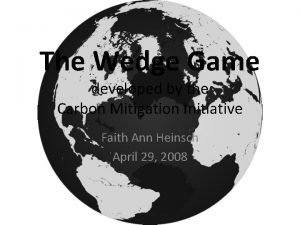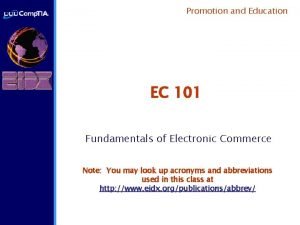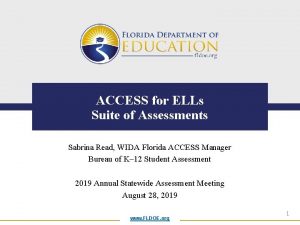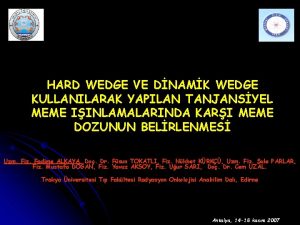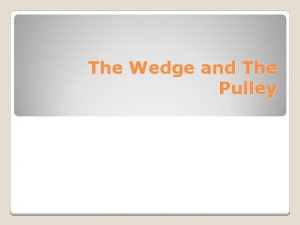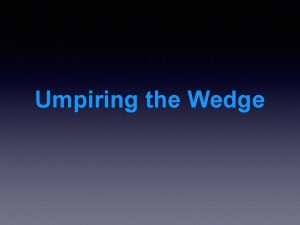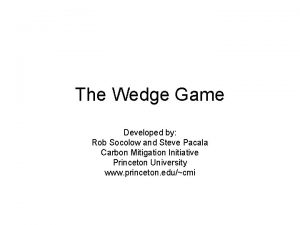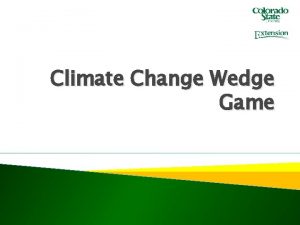The Wedge Game Education Applications The Wedge Game











- Slides: 11

The Wedge Game: Education Applications The Wedge Game presented in slides 2 -6 developed by: Rob Socolow and Steve Pacala Carbon Mitigation Initiative Princeton University www. princeton. edu/~cmi R. Cooter & K. Cooter, 2011 1

Historical emissions profile Billions of Tonnes of Carbon Emitted per Year Science, Vol 305, Issue 5686, 968 -972, 13 Aug. 2004 14 Scientific American, Special Issue, pp. 50 -57, Sept. 2006 Historical emissions 7 1. 9 0 1955 2005 2055 2 2105

The stabilization triangle Billions of Tonnes of Carbon Emitted per Year 14 d te ec th a p oj nt e rr Cu Historical emissions 7 ly pr Stabilization Triangle Flat path O Interim Goal 500 - 550 ppm in 50 years. Steep decline beyond 0 1955 2005 2055 3 2105

Wedges Billion of Tonnes of Carbon Emitted per Year 14 d te ec 14 Bt. C/y th pa oj nt e r r ly pr Seven “wedges” Cu Historical emissions 7 Flat path O 0 1955 2005 2055 7 Bt. C/y 4 2105

What is a wedge? An activity that reduces emissions to the atmosphere that starts at zero today and increases linearly until it accounts for 1 Bt. C/yr of reduced carbon emissions in 2055 1 Bt. C/yr Total = 25 B tonnes of carbon 50 years 5

What are the options? Nuclear Fission CO 2 Capture and Storage 14 Bt. C/y Stabilization Triangle Forests & Soils 2005 Fuel Switching Energy Efficiency and Conservation 7 Bt. C/y 2055 Renewable Electricity and Fuels 6

Questions: Are the data for education in America analogous to the issues raised by Socolow and Pacala in their Carbon Mitigation Initiative? How might we apply “Wedge Theory” logic for improving education for those living in poverty circumstances? Let’s take a brief look at some education data… R. Cooter & K. Cooter, 2011 7

8 th grade (Note: National Avg. = 156) R. Cooter & K. Cooter, 2011 8

8 th grade (Note: National Avg. = 156; Female avg. = 166, Male avg. = 146) 9

So, how might we define an educational wedge for improving learning for kids from poverty? An intervention that helps increase student learning, reduce the drop-out rate*, AND effectively eliminates a defined portion of the achievement gaps between racial, ethnic, and socio-economic groups by 2022? __% / yr INTERVENTION 10 years R. Cooter & K. Cooter, 2011 10

THINK / GROUP CONSENSUS / SHARE THINK- On your own, write down four “wedges” you feel would be effective in achieving the stated goal. GROUP CONSENSUS – In your assigned group, each person will share their top “wedge” in achieving the goal. (Have someone record each person’s goal as you go along. ) After each person has shared their top goal, repeat the process until everyone has share their four wedges. Next, your group must come to consensus on four wedges they feel might achieve the goal. Record your group’s four wedges on chart paper. SHARE – Elect a spokesperson to share your group’s wedges when called upon by the leader. R. Cooter & K. Cooter, 2011 11
